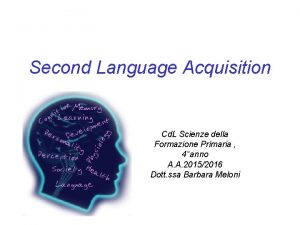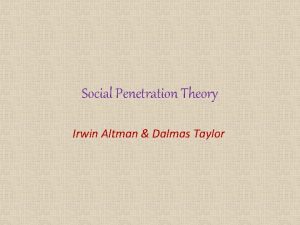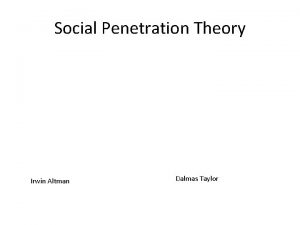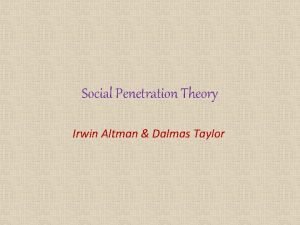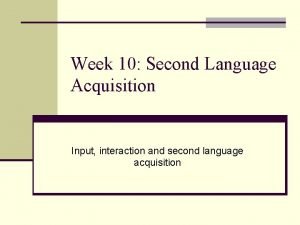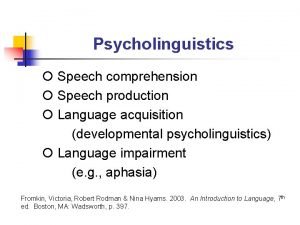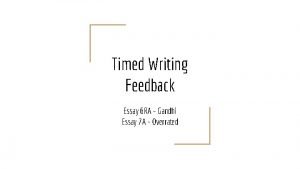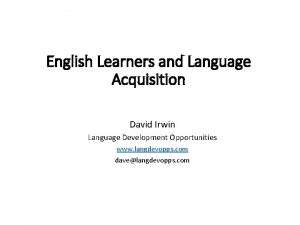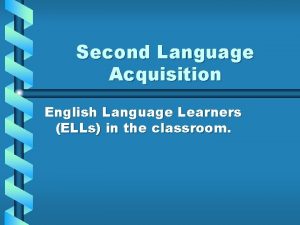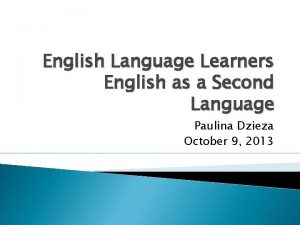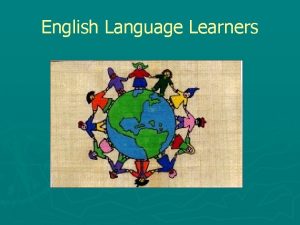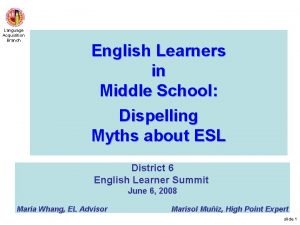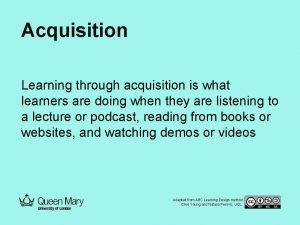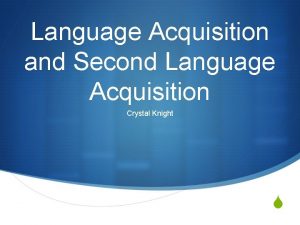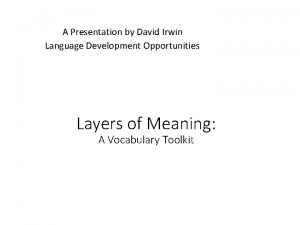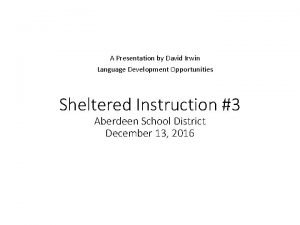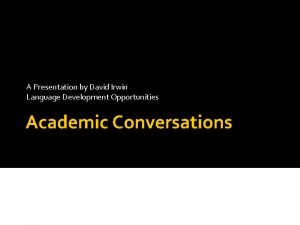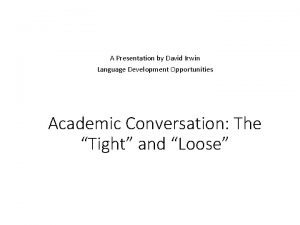English Learners and Language Acquisition David Irwin Language






















- Slides: 22

English Learners and Language Acquisition David Irwin Language Development Opportunities www. langdevopps. com dave@langdevopps. com

Participant Goals Objectives • Understand the process of second language acquisition and the implications for academic learning in English • Make connections between the process and components of language acquisition and the ELP Standards. 2

What Factors Do You Believe Affect Second Language Acquisition? u. Discuss at your table and be ready to share in whole group. (3 minutes)

Conversational Fluency Usually takes between 1 – 2 years to acquire Typically this language provides context and is not cognitively challenging Also called BICS (Basic Interpersonal Communication Skills) Cummins 1979

Cummins: Conversational Fluency u. Formerly BICS: Basic Interpersonal Communication Skills u“Playground English” - conversation in casual settings u. High frequency words Anglo-Saxon based u. Relies on facial expressions, gestures, etc. u. Have it in L 1 by age 5 u. Students have it in L 2 in 1 or 2 years Cummins, J. (1981).

Academic Language Proficiency Usually takes between 5 - 12 years to achieve Discourse is cognitively demanding, often lacks context clues, and is required for literacy and success in content learning Also called CALP (Cognitive Academic Language Proficiency) Cummins 1979

Cummins: Academic Language Proficiency u. Formerly CALP u. Low frequency words Graeco-Roman (Latin) based u. Complex written and oral language u. Technical, specialized language u. Discourse, grammar and vocabulary u 5 -12 years u. The Norman Conquest in 1066 Cummins, J. (1981) Corson, DJ (1985) Thomas & Collier (1997)

The Quantity of BICS v. CALP Conversational Fluency (BICS) Academic Language Proficiency (CALP) Not ‘surface’ language. The iceberg represents the quantity of “BICS words” v. “CALP words” in English. The iceberg will look different for individual students. Cummins 1979

The Iceberg Model With 2 Languages Conversational L 1 L 2 Academic

Alexander Lukin Alexander is 15 and was born and raised in Moscow. He attended public school from the ages of 4 -12. His family then moved to Spokane, Washington. His parents were professors at Moscow University. He went to Shaw Middle School for 1 ½ years. He has been at Lewis & Clark HS since the beginning of the year.

Teresa Gallegos Teresa grew up in the city of San Salvador and went to school there until she was 12. She has basic literacy in Spanish. She moved with her family of six to Othello when she was 16. She attends Othello HS but both of her parents work in the hotel industry, so she is responsible for her siblings after school until 6 pm. She works at Mc. Donald’s from 6: 3010: 30 five nights a week.

Teresa Conversational Academic L 1 L 2

Stages of Language Acquisition ELP Standards �Level 1 Beginning �Level 2 Advanced Beginning �Level 3 Intermediate �Level 4 Advanced �Level 5 Transitional NOTE: These terms were developed by Krashen in 1982 and provide loose descriptions of the levels. They are not seen in the ELP Standards. Krashen (1982) and (2003); WELPA numerical levels

Characteristics of Level 1 • “Silent period” • Uses little or no English. • May or may not connect words with objects or pictures. • Student watches carefully. • Student follows lead of others. • Student repeats language heard in and out of appropriate context. • Needs to see and uses words connected to gestures and actions • Responds to simple academic content and directions • Begins to correct speech in group activities • Needs visual and social academic supports

Characteristics of Level 2 • Mostly silent. • Watches carefully. • Mimics what others do. • Points frequently while communicating. • Repeats words and simple phrases uttered by others but not always with understanding. • Begins to recognize words in the classroom written in English. • Participates in academic discussions with words and phrases • Begins to use content related vocabulary

Characteristics of Level 3 • Speaks simplified English. • Demonstrates frequent grammatical and word choice errors. • Uses simple sentences with inconsistent grammatical forms • Follows simple directions especially when accompanied by gestures. • Uses a few well-chosen English words and phrases to communicate. • Relies on non-linguistic cues for meaning. • Participates in social discussions on familiar topics. • Tells and retells simple stories and content. • Has problems understanding nuances of deeper meaning. • Doesn’t understand many jokes. • Uses word parts to determine meaning of new words (grades 3 to 12) • Reads scaffolded (adapted) text

Characteristics of Level 4 • Speaks clear but simplified English. • Communicates with most speakers on many topics with some ease. • Influence of home language phonology and sentence structures evident. • Begins to self monitor. • At times frustrated due to lack of vocabulary. “Knows what she doesn’t know. ” • May mix home language with English when trying to communicate ideas. • Relies on literal meanings. • Attempts descriptive sentences in academic discussions • Uses common grammatical forms with some errors • Reads at close to grade level with support • Uses simple figurative and idiomatic language (grades 3 to 12)

Characteristics of Level 5 • Uses and understands more complex speech. • Communicates effectively with some language errors. • Jokes and teases easily in English. • May still be confused by idioms. • Speaks clearly and comprehensibly using standard forms. • Applies content related vocabulary in various contexts. • Reads at grade level.

What might a Level 1 student understand? ______ the ____ game __ the ______ball ______, Fernando ______ a _____ __ 73 ______. He ______ 20 ______ in the ____ game, _______ 15. 5 ______ game. To ____ the ______ __ games he ______, _____ the ___ __ 73 and 20 and the_ q ___ the ___ to 15. 5 q ____ 15. 5 ____ 73 q ____ the ___ __ 15. 5 q ______ the ___ __ 15. 5

What might a Level 2 student understand? ______ the last game __ the basketball ______, Fernando had ______ a _____ of 73 points. He ______ 20 points in the last game, ______ his _______ 15. 5 points ___ game. To find the _____ number of games he ______, first find the ___ of 73 and 20 and then q ___ the ___ to 15. 5 q ____ 15. 5 ____ 73 q Multiply the ___ by 15. 5 q ______ the ___ by 15. 5

What might a Level 3 -4 student understand? Before the last game of the basketball season, Fernando had ______ a total of 73 points. He ______ 20 points in the last game, making his season _______ 15. 5 points per game. To find the total number of games he played, first find the sum of 73 and 20 and then q Add the sum to 15. 5 q Subtract 15. 5 from 73 q Multiply the sum by 15. 5 q Divide the sum by 15. 5

What’s so important about language? Before the last game of the basketball season, Fernando had scored a total of 73 points. He scored 20 points in the last game, making his season average 15. 5 points per game. To find the total number of games he played, first find the sum of 73 and 20 and then: ü ü Add the sum to 15. 5 Subtract 15. 5 from 73 Multiply the sum by 15. 5 Divide the sum by 15. 5
 Language acquisition vs language learning
Language acquisition vs language learning Audioize
Audioize English language learners
English language learners Reading strategies for english language learners
Reading strategies for english language learners Cr part 154
Cr part 154 Teaching young learners english
Teaching young learners english Corso di laurea in scienze della formazione primaria
Corso di laurea in scienze della formazione primaria Compare and contrast first and second language acquisition
Compare and contrast first and second language acquisition Irwin altman & dalmas taylor
Irwin altman & dalmas taylor Irwin altman & dalmas taylor
Irwin altman & dalmas taylor Dalmas taylor
Dalmas taylor The code of ethics for professional teachers
The code of ethics for professional teachers Government program for gifted students in the philippines
Government program for gifted students in the philippines Active and passive learners
Active and passive learners Input interaction and second language acquisition
Input interaction and second language acquisition Garden path sentence
Garden path sentence Systematicity and variability in first language acquisition
Systematicity and variability in first language acquisition Gandhi's letter to lord irwin
Gandhi's letter to lord irwin Gandhi rhetorical analysis
Gandhi rhetorical analysis Acherola
Acherola Intermediate math problems for students by m. colwell
Intermediate math problems for students by m. colwell Forensic engineer jobs
Forensic engineer jobs Jimmy irwin
Jimmy irwin






